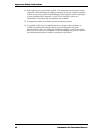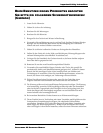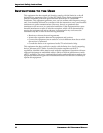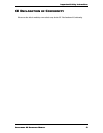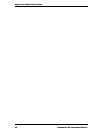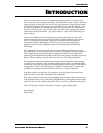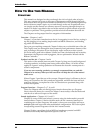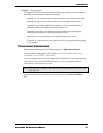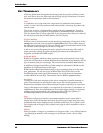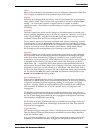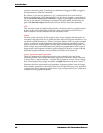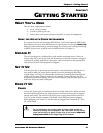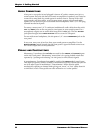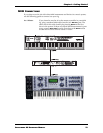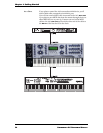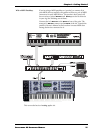
Introduction
18 ANDROMEDA A6 REFERENCE MANUAL
KEY TERMINOLOGY
While we define terms throughout this manual, and also provide a Glossary at the
end, we’d like to list a few terms now that will help you get a head start on some of
the technical expressions used in this document:
Voice
A synthesizer voice is the most basic component of a synthesizer that produces
sound. A voice is all of the hardware and software that is necessary to produce one
note of sound.
The A6 has 16 voices: 16 independent “sound-producing components” that play
when a key or keys are played on its keyboard, or when MIDI Notes are received.
This also means that 16 voices is the limit: if you play more than 16 keys at a time (or
the A6 receives more than 16 MIDI Notes), only 16 will play.
Program and Mix
Where a voice is the instrument’s sound-producing component, a Program is all the
settings that cause the voices to produce a particular sound. This is where many of
the front panel controls come in. They are used to create the individual sounds of the
A6 and their values (settings) are stored as a Program.
A Mix is two or more Programs that can be played at the same time. Mix mode is
where you make settings for splits and layers plus numerous combinations of
Programs, and keyboard/MIDI control.
RAM and ROM
Related to Programs and Mixes, these two terms refer to the physical circuit chips
inside the A6 where data is stored. RAM stands for Random Access Memory and is a
type of memory that you can change. This manual refers to RAM as user memory.
In addition to Programs and Mixes, Global setings are also stored in RAM (see the
definition of Global mode later in this topic).
ROM stands for Read Only Memory and is a type of memory that is, for the most
part, permanent. The A6 uses a type of ROM called Flash ROM which can be
modified but only under special circumstances. So, for all intents and purposes,
consider ROM to be read-only. This manual refers to ROM as preset memory.
Parameter
Virtually all of the main functions of the A6 are comprised of smaller elements or
parts. These elements are all related in some way to the overall operation of the
function they constitute. Each of these elements or parts is referred to as a parameter.
Using an Envelope as an example, it is comprised of no less than 47 parameters: six
adjustments for time, five adjustments for level, eight trigger settings, six dynamics
settings, eight loop parameters, plus settings for slope (with nine options), 12
modulation parameters and clock-synchronization settings.
Page
The display will group a function’s parameters together on the screen called a
display page. Some A6 functions have more than one page because they have more
parameters than can be displayed in the available screen area. This is called a multi-
page display and each page’s title is printed on a page tab which resembles a tab in a
notebook.
Editing
When you make a change to a parameter in a Program or Mix, or to a Global function
– by adjusting its numeric value, turning it on or off and so forth – this is called
editing.



